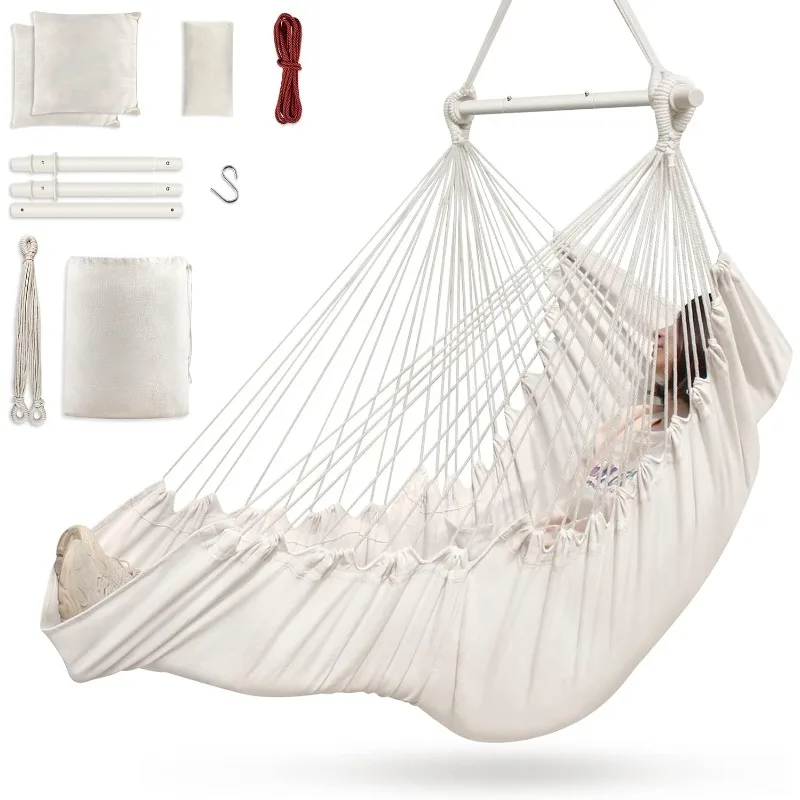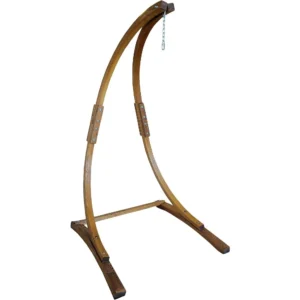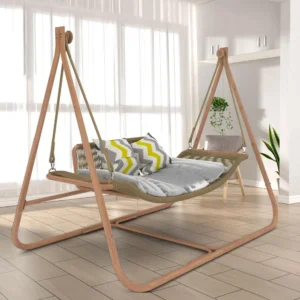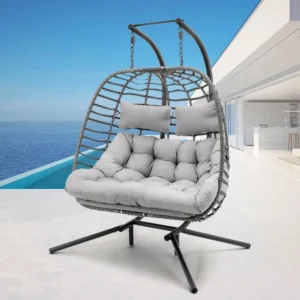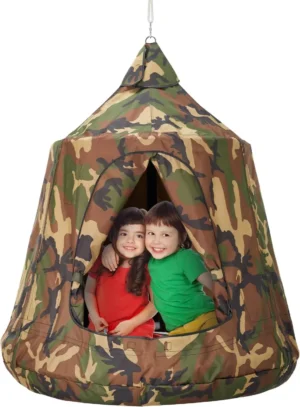Why a Swinging Hammock Chair Transforms Your Patio Experience
There’s something magical about the gentle sway of a hammock chair that traditional patio furniture simply can’t provide. Swinging hammock chairs create an instant sense of retreat and relaxation in your outdoor space, transforming an ordinary patio into a personal oasis. Unlike stationary chairs that merely provide a place to sit, these suspended seats offer a multi-sensory experience that engages your body and mind.
The appeal of swinging hammock chairs extends beyond comfort alone:
- Natural stress reduction – The gentle rocking motion stimulates the brain’s relaxation response, similar to the calming effect of rocking chairs
- Space efficiency – They typically occupy 60-70% less floor space than traditional patio sets, making them ideal for small areas
- Visual interest – Their unique suspended design creates a focal point that elevates your patio’s overall aesthetic
- Versatility – They work equally well as statement pieces or complementary additions to existing outdoor furniture
The advantages of swing chairs for patios are particularly notable because they combine function, form, and feeling in a way few other outdoor furnishings can achieve. Research suggests that gentle swinging motions can lower blood pressure and reduce anxiety, essentially turning your patio into a stress-management zone disguised as stylish seating.
Essential Features That Make a Hammock Chair Truly “Patio-Friendly”
When we describe a hammock chair as “patio-friendly,” we’re referring to specific characteristics that make it suitable for outdoor environments. Not all hammock chairs are created equal when it comes to withstanding the challenges of outdoor use.
Weather Resistance Capabilities
The primary distinction between indoor and patio-friendly hammock chairs lies in their ability to withstand the elements. Look for materials specifically rated for outdoor use, including UV-stabilized fabrics that won’t fade quickly and water-resistant or quick-drying materials that won’t develop mildew after rain. Metal components should feature anti-rust treatments or be made from naturally corrosion-resistant materials like aluminum.
Size Considerations for Patios
While hammock chairs are inherently space-saving compared to traditional patio furniture, their dimensions still matter. The ideal patio swing chair features include appropriate sizing for your available space, with compact options for smaller patios and more generous designs for larger areas. Remember to account not just for the chair itself but for the full arc of its swing.
Stability Requirements
Patio surfaces vary widely—from concrete and wood decking to pavers and tiles. A truly patio-friendly hammock chair must remain stable regardless of the surface. Free-standing models should have wide, weighted bases or stabilizing features, while hanging versions need secure mounting options compatible with various ceiling materials.
Maintenance Considerations
Low-maintenance features are essential for outdoor furniture. The best swinging hammock chair sets include removable, washable covers, weather-resistant hardware, and minimal nooks where debris can accumulate. Easy cleaning and simple seasonal maintenance make the difference between a chair that lasts for years and one that quickly becomes an eyesore.
Space-Saving Solutions: Finding the Perfect Size for Your Patio
Understanding space requirements is crucial for harmoniously integrating a hammock chair into your patio environment. Unlike stationary furniture, hammock chairs need room to swing, which requires thoughtful planning.
For standard hanging hammock chairs, allow for a minimum circular footprint of about 4 feet (1.2 meters) in diameter. This accounts for the gentle swinging motion without bumping into walls, railings, or other furniture. Free-standing models with frames typically require a footprint of 3.5-4 feet (1.1-1.2 meters) wide by 4-5 feet (1.2-1.5 meters) deep.
Vertical clearance is equally important—aim for at least 6.5-7 feet (2-2.1 meters) of ceiling height for hanging models to ensure comfortable entry and exit without stooping. Most importantly, consider the chair’s position when in use—the swinging motion should never place the user at risk of colliding with nearby objects.
For smaller patios and balconies, consider:
– Compact designs that hang closer to their mounting point
– C-stand models that have a smaller footprint than A-frame stands
– Wall-mounted swing arms that eliminate the need for ceiling mounts or floor space
Perfectly positioning your swing hammock chair involves measuring your available space and visualizing the arc of motion before committing to a specific location. Remember that hammock chairs can actually make a space feel larger by drawing the eye upward and utilizing vertical space that would otherwise go unused.
Weather-Ready Design: Materials That Withstand the Elements
Choosing weather-appropriate materials is perhaps the most crucial factor in selecting a patio hammock chair that truly lasts. The constant exposure to sun, rain, temperature fluctuations, and possibly snow demands thoughtfully designed products.
Frame Materials for Outdoor Durability
- Powder-coated steel: Offers excellent strength and weight capacity (typically 250-350 lbs) with rust protection; requires inspection for scratches that could compromise weather resistance
- Aluminum: Naturally rust-resistant and lightweight, making it ideal for portable options; typically supports 200-300 lbs
- Weather-treated hardwoods: Provide natural beauty but require more maintenance; cypress, teak and cedar offer natural weather resistance; support varies by design (typically 200-275 lbs)
- Heavy-duty resin or HDPE: Completely weatherproof and maintenance-free; may offer less weight capacity (180-250 lbs) but excellent longevity
Fabric Considerations for Outdoor Exposure
The materials used in patio hammock chairs must balance comfort with resilience. The best outdoor fabrics include:
- Solution-dyed acrylics: These fabrics (like Sunbrella®) have color throughout the fiber, not just on the surface, preventing fading for 3-5 years of direct sun exposure
- Olefin/polypropylene: Naturally water-resistant and quick-drying; resists staining and mildew
- Polyester blends with UV inhibitors: More affordable with decent 1-3 year performance before showing significant fading
- Textilene/PVC-coated mesh: Extremely durable and quick-drying; maintains tension without stretching over time
Comprehensive weather protection for patio hammock chairs also includes considerations like seam construction (look for reinforced, double-stitched seams), hardware quality (stainless steel or aluminum fasteners), and proper drainage design to prevent water pooling in seat areas.
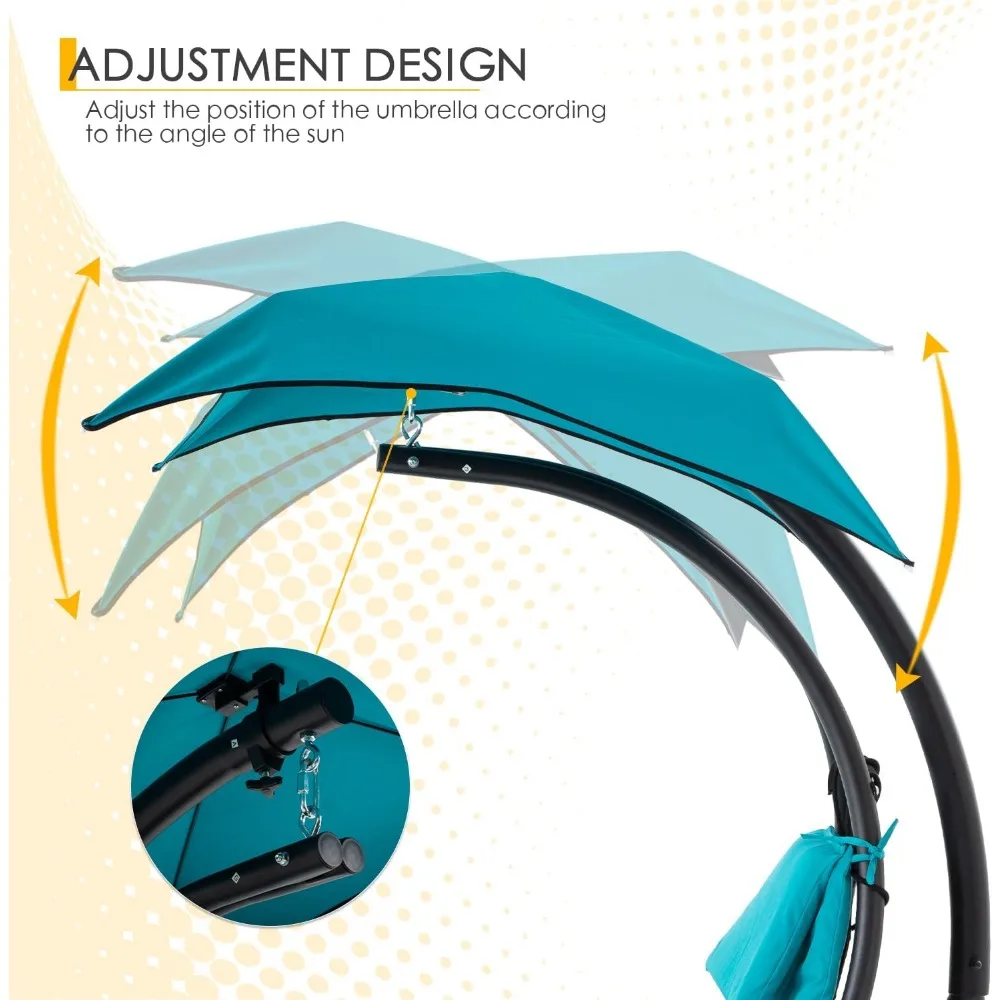
Stability & Safety: Ensuring Secure Relaxation on Your Patio
Safety should never be compromised when selecting a patio hammock chair. Understanding weight capacity and stability factors ensures both peace of mind and physical wellbeing during use.
Most quality hammock chairs support between 250-350 pounds (113-159 kg), but this rating assumes proper installation and weight distribution. Always check the manufacturer’s specific weight limit and choose models that offer at least 50 pounds more capacity than needed to account for dynamic movement while swinging.
Different patio surfaces present unique stability challenges:
* Concrete patios: Provide excellent stability for free-standing models but require specialized anchors for hanging versions
* Wooden decks: Support both hanging and stand-alone models but may require reinforcement at mounting points
* Pavers and tiles: May require additional base support for stands to prevent wobbling or tipping
* Uneven surfaces: Need adjustable feet on stands or special leveling hardware
Understanding hammock load capacity includes recognizing that weight distribution matters as much as total weight. Look for chairs with reinforced stress points, spreader bars that maintain shape, and double or triple attachment points for hanging models.
Safety features to prioritize include:
* Locking mechanisms on folding stands
* Safety chains as backup support for hanging models
* Anti-tip designs for free-standing options
* Smooth, finished edges to prevent fabric tearing or skin scratches
For those seeking maximum stability, hammock chairs with stands offer ready-to-use security without installation concerns. These provide the relaxing benefits of a hammock chair while eliminating worries about mounting hardware or structural support requirements.
Stand-Alone vs. Hanging: Which Chair Style Works Best for Your Patio?
The choice between free-standing and hanging hammock chairs represents one of the most significant decisions when selecting a patio-friendly option. Each approach offers distinct advantages and challenges, particularly in outdoor settings.
Free-Standing Hammock Chairs (With Stands)
Pros:
* No installation or mounting required
* Portable and repositionable around your patio
* No need for structural support from ceilings or beams
* Can be easily moved for seasonal storage
* Often include additional features like canopies or side tables
Cons:
* Typically require more floor space (3.5-5 feet diameter footprint)
* May have lower weight capacity than properly mounted hanging chairs
* More visible hardware and structural elements
* Potentially less stable in windy conditions without anchoring
Ideal for: Renters, concrete patios without overhead structures, those who value flexibility in positioning, and situations where drilling into structures isn’t possible or desirable.
Hanging Hammock Chairs
Pros:
* More authentic swinging motion with greater range
* Smaller floor footprint (just the area beneath the chair)
* Often appear more visually elegant without visible stands
* Typically allow for more spinning and multidirectional movement
* Generally more stable once properly installed
Cons:
* Require structural mounting and installation
* Need ceiling joists, beams, or specialized mounting hardware
* Less portable once installed
* Installation may void rental agreements or require professional help
Ideal for: Homeowners with permanent patios, covered porches with strong overhead beams, and those seeking the most authentic swinging experience with minimal visual interruption.
For many patios, the decision comes down to structural considerations and personal preference. The ultimate swinging chair installation approach depends on your patio’s specific characteristics. When structural limitations exist, convertible models that can work either with stands or as hanging chairs offer welcome flexibility for changing needs or seasonal repositioning.
Top Patio-Friendly Hammock Chair Styles for Every Design Preference
The aesthetic appeal of your hammock chair plays a crucial role in how it enhances your patio’s overall design. From bohemian to modern, there’s a style to complement every outdoor space.
Egg/Cocoon Chairs
These enclosed, pod-like designs offer a sense of privacy and protection while adding dramatic visual impact. Their curved, continuous forms create an instantly recognizable silhouette that serves as a design statement. Hanging egg chairs typically feature:
- Synthetic rattan or wicker exteriors with weather-resistant coatings
- Generous interior cushioning for full-body comfort
- Modern appearance that pairs well with contemporary patio designs
- Higher weight capacity (typically 265-350 lbs) for maximum stability
Macramé and Rope Chairs
Perfect for bohemian or coastal designs, these artisanal-style chairs bring organic texture and handcrafted appeal:
- Intricate knotting patterns create visual interest even when not in use
- Cotton or synthetic rope options (synthetic offers better weather resistance)
- Lightweight design makes them easy to remove and store during inclement weather
- Often feature decorative tassels or fringe details that move with the breeze
Fabric Sling Chairs
These versatile options prioritize comfort while offering the widest range of color choices:
- Canvas, Sunbrella, or polyester blends provide comfortable body contouring
- Available in countless colors to match or accent existing patio décor
- Often feature removable, washable covers for easy maintenance
- Lightweight and typically foldable for off-season storage
Wicker/Rattan Pod Chairs
These traditional favorites offer timeless appeal with modern weather-resistant updates:
- Synthetic wicker provides the classic look without natural rattan’s vulnerability to moisture
- Open-weave designs allow air circulation for comfort in hot weather
- Substantial appearance anchors patio design schemes
- Pairs well with traditional and transitional outdoor furnishings
Modern Architectural Designs
For contemporary patios, these clean-lined options make bold statements:
- Metal frames with minimalist silhouettes
- Monochromatic color schemes in neutral tones
- Geometric rather than organic forms
- Integration of modern materials like powder-coated aluminum and performance textiles
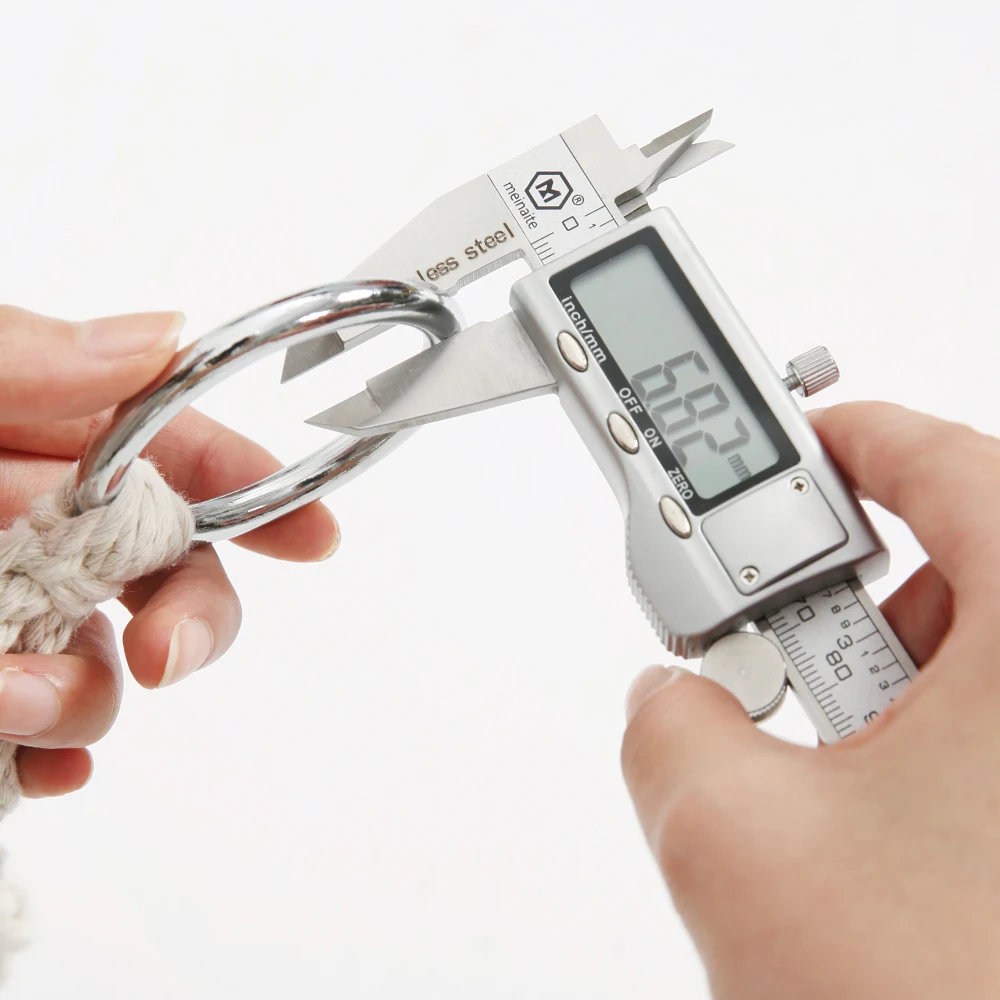
Material Mastery: Selecting for Longevity and Comfort Outdoors
The materials used in your hammock chair directly impact both its lifespan and comfort level when used outdoors. Making informed choices requires understanding how different materials perform in outdoor conditions.
Frame Materials Comparison
Powder-Coated Steel
* Provides maximum stability and highest weight capacity
* Requires checking for paint chips that could allow rusting
* Heavy and less portable than alternatives
* Typically lasts 5-8 years with proper maintenance
Aluminum
* Naturally rust-resistant without special coatings
* Lightweight yet strong (typically 30-40% lighter than steel)
* Higher-end options feature marine-grade quality for coastal environments
* Can last 8-12+ years with minimal maintenance
Hardwood
* Provides natural beauty that synthetic materials can’t match
* Requires annual treatment with oils or sealants
* Ages with attractive patina rather than degrading
* Properly maintained teak or cedar frames can last 10-15+ years
Seat Material Considerations
Synthetic Wicker/Resin
* Mimics natural materials without their vulnerability to moisture
* UV-stabilized versions resist fading and brittleness
* Requires simple cleaning with mild soap and water
* Expected outdoor lifespan of 5-7 years
Weather-Resistant Fabrics
* Solution-dyed acrylics (like Sunbrella) offer 3-5 years of color fastness
* Quick-drying polyester blends prevent mildew growth
* Removable covers extend lifespan through washing or replacement
* Look for double-stitched seams with marine-grade thread
Cushion Materials
* Quick-dry foam prevents water retention and mildew
* Polyfill alternatives provide better moisture resistance than natural fillings
* Breathable designs with mesh bottoms enhance air circulation
* Removable inner cushions allow for thorough drying after rain
For maximum comfort without sacrificing durability, consider deep seat chair hammock sets that combine ample cushioning with weather-resistant construction. These options provide the plush comfort typically associated with indoor furniture while incorporating the weather-resistant features necessary for outdoor use.
Installation Guide: Setting Up Your Hammock Chair on Various Patio Types
Proper installation ensures both safety and optimal enjoyment of your patio hammock chair. The approach varies significantly depending on whether you’ve chosen a free-standing or hanging model.
For Free-Standing Models:
- Unpack and inventory all components before beginning assembly
- Assemble the base first, ensuring all connections are tight and secure
- Check stability by gently rocking the assembled frame before attaching the chair
- Level the base using included adjustable feet or shims for uneven surfaces
- Attach the chair component following manufacturer’s instructions for proper height
- Test weight capacity gradually, first with gentle pressure, then full weight
For maximum stability on various patio surfaces, consider A-frame stand hammock sets which provide broad, stable bases suitable for almost any outdoor flooring material.
For Hanging Models:
- Locate appropriate structural support (ceiling joist, beam, or sturdy branch)
- Use a stud finder for ceiling joists or consult building plans when necessary
- Select appropriate hardware rated for at least 600 pounds (272 kg)—much higher than the chair’s stated capacity—to account for dynamic forces
- Install mounting hardware securely, using lag bolts at least 3/8” thick and 3.5” long for wood structures
- Use expansion bolts or toggle anchors for concrete ceilings
- Hang the chair with proper height adjustment allowing feet to touch the ground when seated
For Uneven Patio Surfaces:
- Use adjustable legs on free-standing models
- Consider concrete pavers under stand legs to create level surfaces
- For hanging models, adjust rope or chain length to achieve proper height despite sloped ceilings
- Use weather-resistant shims where necessary to prevent wobbling
Always perform a safety check after installation, including a “bounce test” with gradual weight application, inspection of all connection points, and verification that the chair hangs at an appropriate height for comfortable entry and exit.
Strategic Placement: Creating the Perfect Relaxation Zone on Your Patio
The location of your hammock chair dramatically affects both its usability and your overall patio experience. Thoughtful positioning transforms a simple seating option into a dedicated relaxation zone.
Consider these key factors when deciding where to place your hammock chair:
Sun/shade balance – Track sun patterns across your patio throughout the day. Morning sun with afternoon shade often provides the ideal combination for year-round comfort.
Wind patterns – Position chairs where they’re protected from prevailing winds while still allowing gentle breezes. Corner locations often provide natural windbreaks.
Visual focus – Orient the chair toward pleasant views (gardens, landscapes, water features) rather than utility areas or neighbor’s windows.
Privacy considerations – Create a sense of seclusion using strategic placement near existing structures, plants, or privacy screens.
Traffic flow – Ensure the chair’s swing path doesn’t interfere with walking routes through your patio space.
For optimal layout planning, consider how your hammock chair relates to other patio elements:
- Place chairs 3-4 feet (0.9-1.2 meters) from other furniture pieces to allow comfortable conversation distances
- Position near small side tables (18-24 inches high) for convenient placement of drinks or books
- Create conversation groupings by placing two chairs in L-shaped arrangements
- Use outdoor rugs beneath free-standing models to define the relaxation zone visually
The best patio hammock swing chairs complement their surroundings while creating a distinct destination within your outdoor space. Remember that seasonal adjustments may be necessary—positions that work perfectly in spring might receive too much direct sun by midsummer.
Maintenance Made Easy: Protecting Your Outdoor Hammock Chair Investment
Proper maintenance dramatically extends the lifespan of your patio hammock chair while keeping it looking and functioning at its best. With simple, consistent care, many quality chairs can provide a decade or more of relaxation.
Seasonal Maintenance Schedule
Spring:
* Remove winter covers and inspect for any damage
* Tighten all hardware and connections
* Clean thoroughly after winter storage
* Check rope or chain condition for hanging models
Summer:
* Rinse fabric components monthly to remove pollen and dust
* Apply fabric guard to non-treated textiles
* Check and tighten hardware that may loosen with frequent use
* Inspect stand stability on free-standing models
Fall:
* Deep clean before potential storage
* Apply protective treatments to wood components
* Check for UV damage and address as needed
* Repair any minor damage before it worsens
Winter:
* Apply weather covers or store indoor in harsh climates
* Elevate from ground if leaving outdoors
* Remove cushions for indoor storage
* Apply rust inhibitor to exposed metal parts
Weather-resistant hammock chairs benefit from specific cleaning approaches based on their materials:
- Synthetic wicker/resin – Clean with mild soap solution and soft brush; rinse thoroughly
- Outdoor fabrics – Spot clean with diluted dish soap; avoid bleach unless specifically recommended by manufacturer
- Metal frames – Wipe with damp cloth and inspect for rust spots or paint damage
- Wood components – Clean with appropriate wood cleaner and apply sealant annually
Regular maintenance not only extends your chair’s lifespan but also ensures it remains safe for use. Pay particular attention to weight-bearing connections, looking for fraying ropes, stretching chains, or loosening hardware before they become safety hazards.
Dark Wood Hammock Sets, Porch Swing Chair Sets
$653.82 Select options This product has multiple variants. The options may be chosen on the product pageA-Frame Stand Hammock Sets, Swinging Hammock Chair Sets
$154.62 Select options This product has multiple variants. The options may be chosen on the product pageLight Wood Hammock Sets, Swinging Hammock Chair Sets
$1,359.35 Select options This product has multiple variants. The options may be chosen on the product pageHammock Sets with Canopy, Heavy Duty Hammock Sets
$286.31 Select options This product has multiple variants. The options may be chosen on the product page- $963.29 Select options This product has multiple variants. The options may be chosen on the product page
Complete Camping Hammock Systems, Hanging Egg Chair Sets
$266.73 Select options This product has multiple variants. The options may be chosen on the product page
Complete Your Outdoor Oasis: Perfect Accessories for Your Hammock Chair
The right accessories transform your hammock chair from simple seating into a complete relaxation station. These complementary elements enhance comfort, convenience, and style while extending your chair’s usefulness throughout the day and evening.
Comfort Enhancers
- Lumbar pillows designed specifically for curved seating provide essential back support
- Neck pillows with weather-resistant covers prevent strain during longer relaxation sessions
- Footrests or ottoman poufs complete the lounging experience for full-body comfort
- Seat cushions with quick-dry technology add plushness without moisture retention
Convenience Additions
- Side tables (freestanding or attachable) keep drinks, books, and devices within easy reach
- Cup holders that clip onto chair frames prevent spills while swinging
- Storage pockets that hang alongside chairs keep small items organized
- Tablet holders for hands-free entertainment while relaxing
Weather Protection
- Attachable canopies provide shade without relocating your chair
- Furniture covers with breathable, water-resistant fabrics extend longevity
- Water-repellent sprays for fabric refreshing between deeper cleanings
- Hammock chairs with protective canopies for built-in sun protection
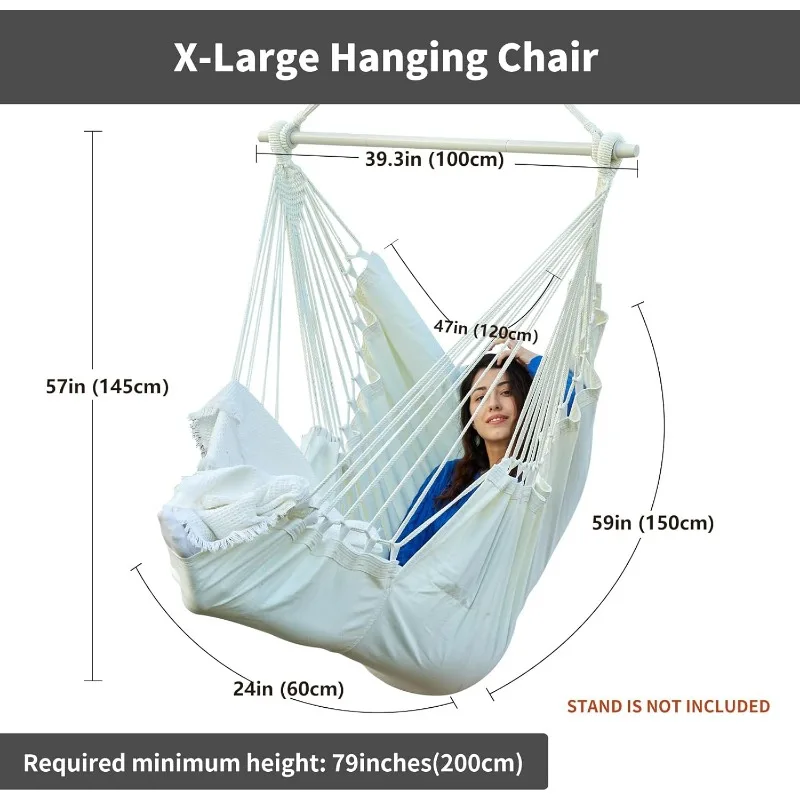
Ambiance Enhancements
- Solar-powered string lights for evening enjoyment without electrical connections
- Outdoor pillows in complementary colors to tie the chair into your overall patio design
- Small plant stands positioned nearby to create a green sanctuary feeling
- Weather-resistant throw blankets for cooler evenings
The beauty of accessorizing your hammock chair lies in the ability to customize according to your specific needs and patio style. Start with essentials like weather protection, then add comfort and convenience items as you discover how you most frequently use your chair.
What to Ask Before You Buy: Essential Questions for Smart Selection
Making an informed hammock chair purchase requires asking the right questions. Use this checklist to evaluate options and find the perfect match for your patio:
Space Requirements
* What are the exact dimensions of the fully assembled chair?
* How much clearance is needed for comfortable swinging?
* What is the total footprint including the stand (for free-standing models)?
* How high must my mounting point be (for hanging models)?
Patio Compatibility
* Is this chair specifically designed for full outdoor exposure?
* How will it perform on my specific patio surface (concrete, wood, pavers)?
* What wind rating can the chair withstand without tipping or requiring anchoring?
* Are there color options that complement my existing patio décor?
Durability Factors
* What is the UV rating of the fabric components?
* How are the metal elements protected against rust and corrosion?
* What is the expected lifespan with proper maintenance?
* Are replacement parts available if components wear out?
Comfort Considerations
* What is the weight capacity of the chair?
* How easily can I get in and out of this design?
* Does it accommodate taller users comfortably?
* Is the seating surface breathable for hot weather comfort?
Value Assessment
* What warranty is provided and what specifically does it cover?
* Are all necessary hardware components included?
* How does the price compare to similar models with equivalent features?
* What accessories are included vs. sold separately?
Understanding how patio chairs compare to swing hammocks helps clarify the value proposition of hammock chairs. While traditional patio chairs may cost less initially, the comfort, space efficiency, and unique experience of hammock chairs often justify their investment for those seeking something beyond ordinary outdoor seating.
Can All Hammock Chairs Withstand Year-Round Outdoor Exposure?
Not all hammock chairs are created equal when it comes to weather resilience. Climate considerations play a crucial role in determining whether year-round outdoor placement is feasible.
In moderate climates with mild winters, most outdoor-rated hammock chairs can remain in place year-round with proper protection. However, regions with extreme conditions present additional challenges:
Hot, sunny climates require superior UV protection to prevent fabric fading and material degradation. Even “outdoor-rated” chairs vary significantly in their UV resistance—look for fabrics with 1000+ hours of UV testing.
Cold, snowy regions demand materials that can withstand freeze-thaw cycles without cracking. Most manufacturers recommend indoor storage when temperatures regularly fall below freezing (32°F/0°C).
Coastal environments need specialized materials resistant to salt air corrosion. Standard powder-coated steel may fail prematurely, while marine-grade aluminum and stainless steel hardware offer better longevity.
High humidity areas require quick-drying, mildew-resistant materials and proper drainage design to prevent water accumulation.
Material limitations become apparent in extreme conditions. Some manufacturers specifically state that their products are “seasonal outdoor use” rather than “permanent outdoor installation.” This distinction matters—seasonal items typically use materials rated for 3-6 months of continuous exposure rather than year-round durability.
For extending lifespan in challenging climates, consider protective covers, seasonal storage of removable components, or selecting indoor-outdoor designs that can be easily relocated during severe weather periods. The initial investment in a truly all-weather design often pays dividends through years of additional service.
How Do I Choose Between Portable and Permanent Installation Options?
The decision between portable and permanent hammock chair installations involves weighing practical considerations against your specific patio situation and personal preferences.
Mobility Benefits
Portable designs offer tremendous flexibility:
* Easily reposition to follow shade patterns throughout the day
* Bring indoors during extreme weather or winter months
* Take to different areas of your property (poolside, garden, deck)
* Transport to vacation homes or camping sites
* Avoid commitment to a single location as your needs change
Permanence Advantages
Fixed installations provide other benefits:
* Greater stability during use, especially for active swingers
* Cleaner aesthetic with less visible supporting structure
* Often support higher weight capacities
* Typically allow more range of motion in swinging
* Reduced footprint since no stand is required
Renter Considerations
For those in rental properties, portable options offer clear advantages:
* No structural modifications required
* No potential security deposit issues
* Ability to take your investment with you when moving
* Flexibility to adapt to rental restrictions
Some manufacturers offer convertible designs—chairs that come with stands but can also be hung from ceiling mounts when desired. These hybrid options provide maximum flexibility for changing living situations or seasonal adjustments.
Storage requirements also factor into this decision. Portable models with folding stands can typically be collapsed to 15-20% of their assembled size for off-season storage in garages or closets. Permanent installations remain in place year-round, potentially requiring weather covers during inactive periods.
Frequently Asked Questions About Patio Hammock Chairs
How much space do I need for a hammock chair on my patio?
For free-standing models, allow a minimum of 4-5 feet (1.2-1.5 meters) in diameter. For hanging versions, ensure at least 3 feet (0.9 meters) of clearance on all sides plus room for the swing arc. Height clearance should be at least 7-8 feet (2.1-2.4 meters) for comfortable use.
Can hammock chairs stay outside all year?
High-quality, outdoor-specific models can remain outdoors year-round in moderate climates with proper protection. In extreme climates (very cold winters, intense sun exposure), seasonal storage of at least the fabric components is recommended to maximize lifespan.
How often should I clean my outdoor hammock chair?
Perform basic cleaning monthly during regular use (more frequently in high-pollen seasons or dusty environments). Deep cleaning should occur twice yearly—typically in spring before heavy use and fall before potential storage.
Are hammock chairs safe for children?
Most quality hammock chairs are safe for children when properly installed and used with adult supervision. Look for models with safety features like stabilizing springs, reinforced seams, and enclosed designs that prevent falls. Always check weight limitations, as some compact models have lower capacity.
How do I keep my hammock chair stable in windy conditions?
For free-standing models, add weight to the base using sandbags or purpose-made weights. Some stands feature built-in hooks for anchoring to the ground. Hanging versions can include stabilizing lines that prevent excessive swinging during windy days.
What’s the weight capacity of typical hammock chairs?
Most quality patio hammock chairs support between 250-350 pounds (113-159 kg), though specialized heavy-duty models can accommodate up to 500 pounds (227 kg). Always check manufacturer specifications and choose a model rated at least 50 pounds above your needs.
Can I leave cushions outside?
Unless specifically labeled as fully weather-resistant, most hammock chair cushions should be brought indoors during rain or stored during extended periods of non-use. Even weather-resistant cushions last longer with protection from constant exposure.

